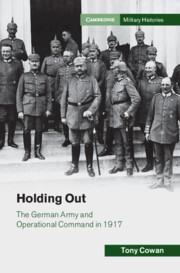Refine search
Actions for selected content:
15401 results in Military history
Appendix - Bombardments and On-the-Ground Responses: Maps and Numerical Comparisons
-
- Book:
- When Men Fell from the Sky
- Published online:
- 21 March 2023
- Print publication:
- 13 April 2023, pp 267-279
-
- Chapter
- Export citation
Numerical Tables
-
- Book:
- When Men Fell from the Sky
- Published online:
- 21 March 2023
- Print publication:
- 13 April 2023, pp xiii-xiii
-
- Chapter
- Export citation
Part I - Blitz-Invasion in France, or Resistance Crushed
-
- Book:
- When Men Fell from the Sky
- Published online:
- 21 March 2023
- Print publication:
- 13 April 2023, pp 21-66
-
- Chapter
- Export citation
Part IV - Lynching in Germany, 1943–1945
-
- Book:
- When Men Fell from the Sky
- Published online:
- 21 March 2023
- Print publication:
- 13 April 2023, pp 183-266
-
- Chapter
- Export citation
1 - Finding the Volunteers of the Year 40
- from Part I - Blitz-Invasion in France, or Resistance Crushed
-
- Book:
- When Men Fell from the Sky
- Published online:
- 21 March 2023
- Print publication:
- 13 April 2023, pp 23-38
-
- Chapter
- Export citation
9 - A Revolutionary Dynamic
- from Part IV - Lynching in Germany, 1943–1945
-
- Book:
- When Men Fell from the Sky
- Published online:
- 21 March 2023
- Print publication:
- 13 April 2023, pp 204-220
-
- Chapter
- Export citation
5 - The Resistance as Mass Local Dynamic
- from Part III - The Origins of the Resistance
-
- Book:
- When Men Fell from the Sky
- Published online:
- 21 March 2023
- Print publication:
- 13 April 2023, pp 111-133
-
- Chapter
- Export citation
Part III - The Origins of the Resistance
-
- Book:
- When Men Fell from the Sky
- Published online:
- 21 March 2023
- Print publication:
- 13 April 2023, pp 109-182
-
- Chapter
- Export citation
Illustrations
-
- Book:
- When Men Fell from the Sky
- Published online:
- 21 March 2023
- Print publication:
- 13 April 2023, pp ix-x
-
- Chapter
- Export citation
Maps
-
- Book:
- When Men Fell from the Sky
- Published online:
- 21 March 2023
- Print publication:
- 13 April 2023, pp xi-xi
-
- Chapter
- Export citation
4 - “British Humor” as an Agent of Civility
- from Part II - “Imminent Invasion!”
-
- Book:
- When Men Fell from the Sky
- Published online:
- 21 March 2023
- Print publication:
- 13 April 2023, pp 84-108
-
- Chapter
- Export citation

Imperial Germany and the Great War, 1914–1918
-
- Published online:
- 07 April 2023
- Print publication:
- 10 July 2014
-
- Textbook
- Export citation

Medieval France at War
- A Military History of the French Monarchy, 885-1305
-
- Published by:
- Amsterdam University Press
- Published online:
- 06 April 2023
- Print publication:
- 30 November 2022
-
- Book
- Export citation

Holding Out
- The German Army and Operational Command in 1917
-
- Published online:
- 31 March 2023
- Print publication:
- 20 April 2023

When Men Fell from the Sky
- Civilians and Downed Airmen in Second World War Europe
-
- Published online:
- 21 March 2023
- Print publication:
- 13 April 2023
23 - The 1813 Campaign in Central Europe
- from Part IV - Napoleon’s Military Campaigns in Europe
-
-
- Book:
- The Cambridge History of the Napoleonic Wars
- Published online:
- 20 December 2022
- Print publication:
- 02 March 2023, pp 471-491
-
- Chapter
- Export citation
Index
-
- Book:
- The Cambridge History of the Napoleonic Wars
- Published online:
- 20 December 2022
- Print publication:
- 02 March 2023, pp 717-744
-
- Chapter
- Export citation
Part IV - Production
-
- Book:
- The British Home Front and the First World War
- Published online:
- 23 February 2023
- Print publication:
- 02 March 2023, pp 357-486
-
- Chapter
- Export citation
Tables
-
- Book:
- The Cambridge History of the Napoleonic Wars
- Published online:
- 20 December 2022
- Print publication:
- 02 March 2023, pp xii-xii
-
- Chapter
- Export citation
21 - The 1809 Campaign against Austria
- from Part IV - Napoleon’s Military Campaigns in Europe
-
-
- Book:
- The Cambridge History of the Napoleonic Wars
- Published online:
- 20 December 2022
- Print publication:
- 02 March 2023, pp 427-448
-
- Chapter
- Export citation
